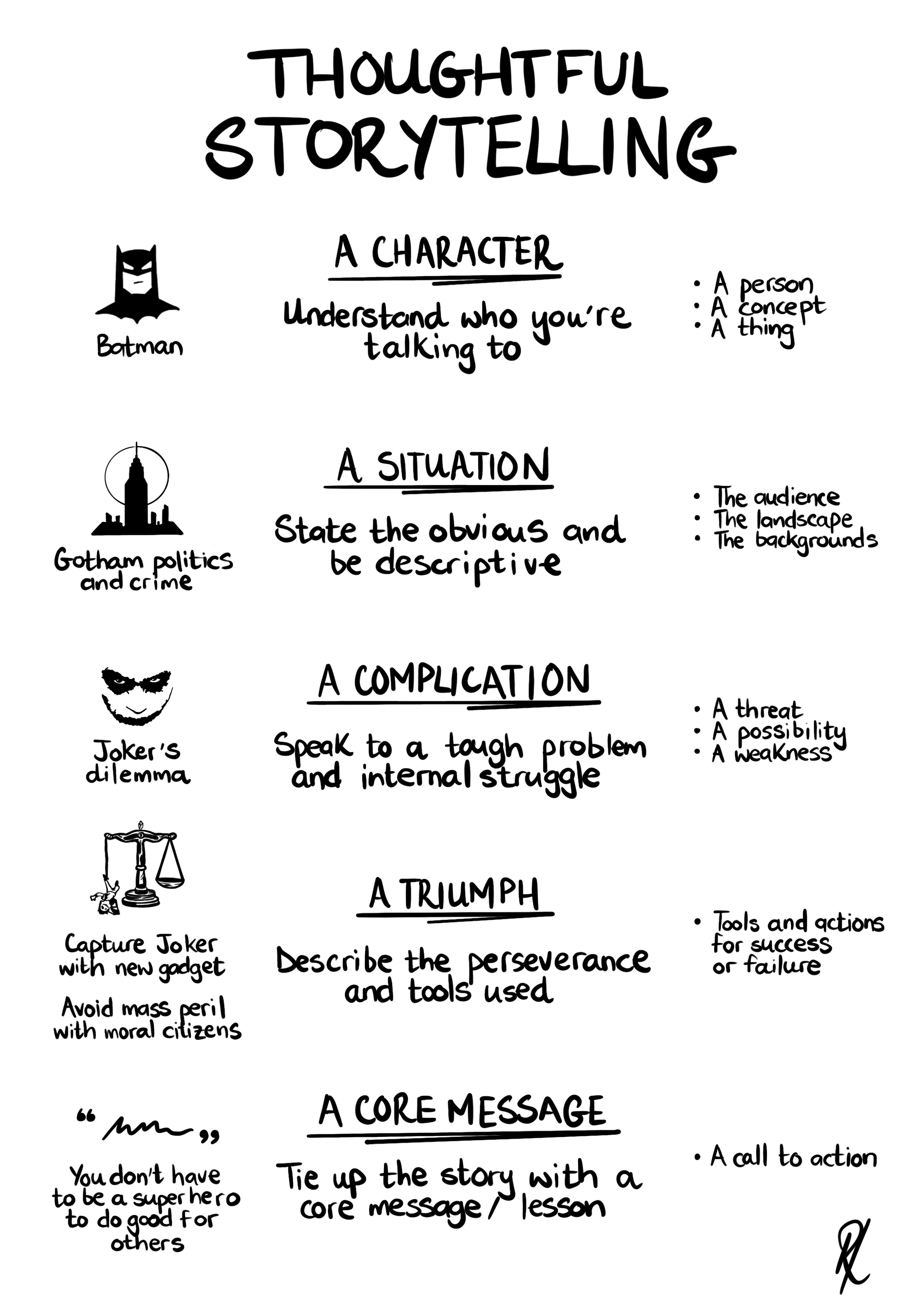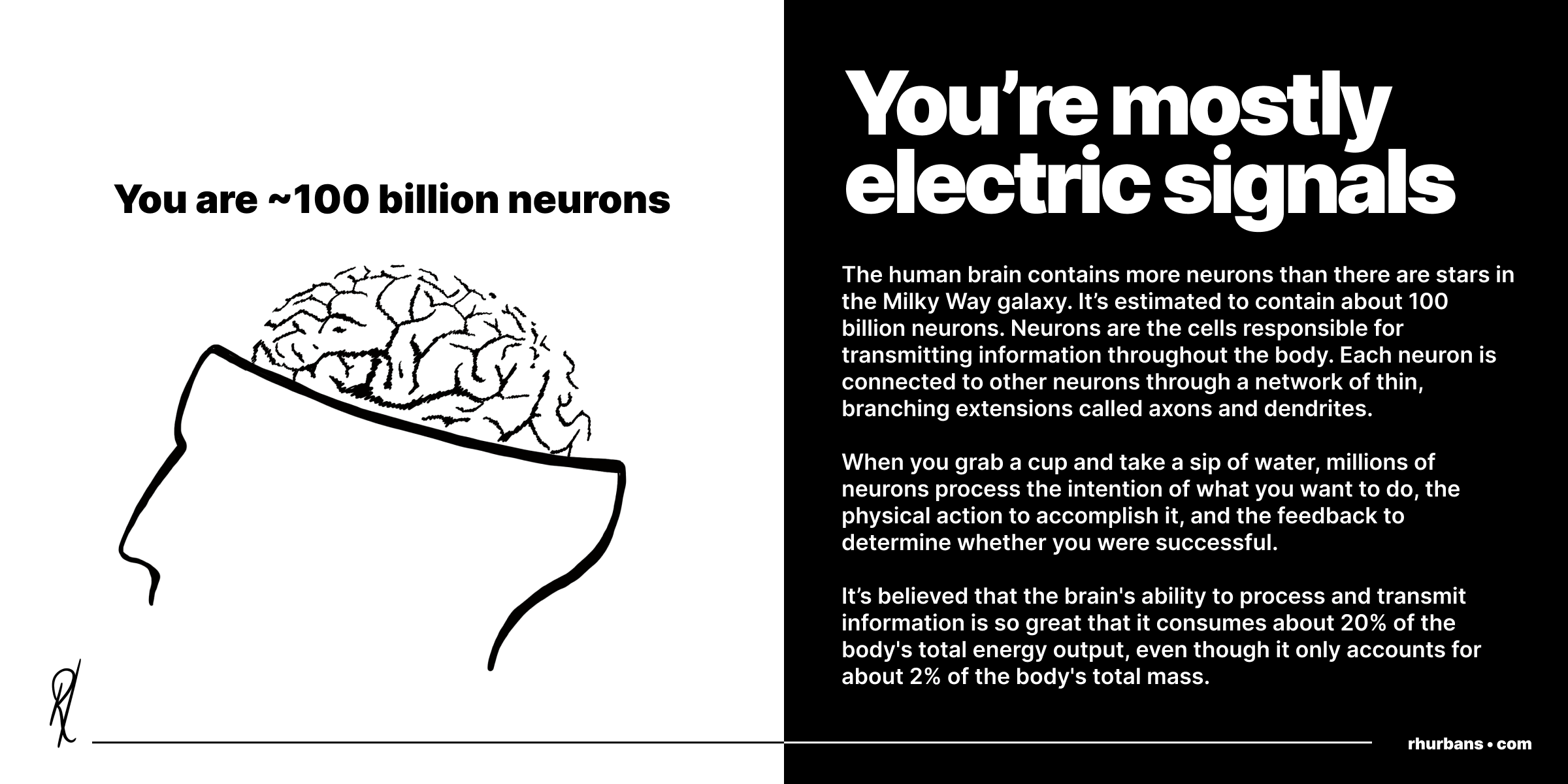Brain food: Storytelling with Batman, and your 100 billion neurons
Welcome to this week's brain food. These aim to be short and easy to digest pieces that enrich your work and life with simple ideas and principles.
Our worlds are shaped by the stories we hear and tell
▓▓▓▓░░░░░░░░░░░
2023 year progress: 25% complete
Today in a nutshell
- Everything you express is more impactful as a "story"
- Each of us and our 100 billion neurons
Thoughtful storytelling
Have you ever tried to explain your project, technical work you've done, or a complex idea to someone who's not necessarily an expert in the area? Everything we express is more impactful as a "story".
Storytelling uses metaphors of things we've all likely experienced, pulls at our heartstrings, and helps us remember information better. When ideas are presented in story form, it's easier to picture and relate to, which makes us more invested in the overall message. Unlike plain facts, figures and technical details, stories and metaphors can explain complex ideas in a way that's easy to grasp and remember.
Ultimately, storytelling makes information more accessible, engaging, and impactful, making it an essential tool for effective communication. Let's explore a blueprint for storytelling by using the movie, The Dark Knight, mirrored with practical examples.

A character
All stories are centred around a main character. This might be,
- an anthropomorphic / human-like character: Like Batman or Albert Einstein.
- a concept / idea: Like the concept of Artificial Intelligence or the Stock Market.
- or a special object: Like the Infinity Stones or the Instagram app.
In whatever story we hear or tell, a character is at its foundation, and often drives the core message of the overall story.
For example, in the movie, The Dark Knight, although there are many supporting characters, the main character is Batman. He is used as the vehicle to explore ideas, and be relatable through his internal moral conflicts.
In our work, the solutions we're building or services we're providing are often the main characters when explaining things to others (Some try to make themselves the main character, but this isn't very effective). The character is the thing we want to centre a conversation around, it's the thing we want people to resonate with.
A situation
When we convey information, we take things for granted. We don't explain the complete landscape, backgrounds of characters, scenarios, and complexities in the situation. Especially when it comes to our work rather than leisure. Stories need to describe the context in rich detail to inform the audience as well as possible.
In The Dark Knight, a good part of the movie is spent describing the current wide-spread criminal activity in the city, exploring the backgrounds of supporting and main characters, and the complexity of the political climate. It also highlights the background of Bruce Wayne (the main character) as a person, and his double-sided persona. It doesn't assume too much knowledge about the Batman universe from the audience.
In our work, we're always communicating concepts to people. We might be explaining the details of a problem to a team member, a break-through idea to a decision-maker, or an app to an end-user. Because we're immersed, we assume part or most of our knowledge on others. We might use acronyms that people aren't necessarily familiar with, reference tools that people haven't used, and gloss over concepts that build the foundation of our "character" or message. Knowing the audience, and explicitly addressing their knowledge gaps helps not just inform, but also create a sense of relatability.
A complication
A story almost always has a tough problem, struggle, or complexity that needs to be overcome. Something shocking that makes the audience wonder how it can possibly be conquered. These complications usually have two facets. An external complication, this is something that's related to the material world and others in it. And an internal complication, this is an emotional complication that's related to the character and ressonates with the audience.
In The Dark Knight, Batman works to resolve the gang-led crime fest, but the Joker makes things more complicated. He disrupts the crime underworld, and creates chaos by manipulating people of importance and creating dilemmas for survival. Furthermore, Batman faces internal moral conflicts. Altogether, an almost impossible struggle to overcome.
In our work, we want to describe the problem we're solving, not necessarily the problem with the character, but the problem that the character is trying to overcome given the situation described. This might be the issue of open knowledge that Wikipedia tries to solve, or the energy crisis that renewable energy tries to solve. By underpinning the story with the character and situation, highlighting the complications is much easier, and gets people invested. Note: Even if there is a complication with the character, for example, a technical issue is preventing progress, it's far easier to explain with a story-based approach.
A triumph
A story must describe the actions, tools, and perseverance of the main character to overcome the tough problem and complexities, and achieve success or open up opportunities. Most stories have some climax that describe how something or someone overcame the complications to become triumphant.
In The Dark Knight, Batman captures the Joker by using his smarts, interesting gadget inventions, and overcoming his internal conflicts through acceptance and sacrifice. The biggest threat was two boats rigged to explode, one with normal citizens, and one with convicts. Each choose whether or not to kill the other boat. This complication is overcome by everyone ultimately remaining moral and choosing not to kill.
In our work, we want to highlight the tools and actions that result in a positive outcome, like success or the creation of possibilities. Given a tough problem, how does the character solve it? What are the tools used or actions taken to solve the tough problems and complications? By describing the steps to success and directly referencing the complications, the audience is relieved that the seemingly impossible was made possible.
A core message
Every story has an underlying message that the storyteller is trying to convey. In a movie, it might be that people are inherently easily persuaded. In gossip, it might be to express dislike towards someone. In our careers, it might be to confidently explain our work, or the benefit of what we're doing.
In The Dark Knight, there are many subtle messages, and some explicit ones. This might be different for each viewer, but I'd say that a core message is that the citizens can do good without being superheroes, superheroes can do good without killing, and at the same time, everyone is somewhat corruptible.
In our lives, we want to distil the story into a simple to understand narrative that resonates with people, and specify the reaction you want. Do you allude to a sequel and want to create anticipation (useful in marketing). Do you want people bought into the work you're doing? This is ultimately the reason why you told the story to begin with.
Storytelling is useful to everyone, no matter your role or goals. It helps you be a better communicator which is a timeless skill to hone. Explore the concept of storytelling with your friends and team. Try a casual workshop on Interacts, a platform we've built to make remote and hybrid sessions engaging and fun.
You are ~100 billion neurons
When you grab a cup and take a sip of water, millions of neurons process the intention of what you want to do, the physical action to accomplish it, and the feedback to determine whether you were successful. This is the exact intuition that we use to create AI systems.

Download the full "Ideas everyone should know" eBook here.
I hope you enjoyed and was enriched by this edition! If you missed the previous edition, read about Survivorship bias and AI app design.
Try Interacts & FancyGPT
I'm dedicated to building solutions that make people more productive and happy. I'd love it if you tried my projects, and appreciate any feedback you have, email me.
🧩 Interacts: A remote and hybrid collaboration tool for engaging workshops, retrospectives, team building and more – InteractsApp.com
🤖 FancyGPT: A Chrome extension to save and share beautiful ChatGPT snippets as images, searchable PDFs, and text files – FancyGPT.com
Share and stay in touch
If you enjoyed today's newsletter, please share it with your friends, family, and colleagues! Also, please "add to address book", it helps with delivery.
If this email was forwarded to you, consider subscribing to receive them in future.
Connect on LinkedIn
Follow on Twitter
Processing your application
There was an error sending the email, please try again
